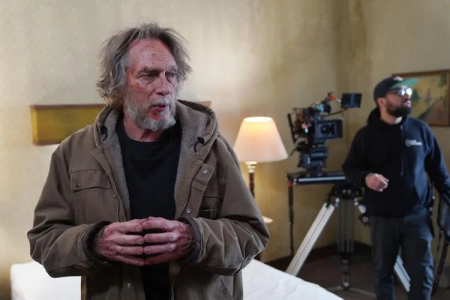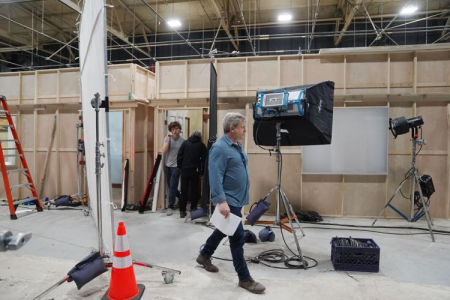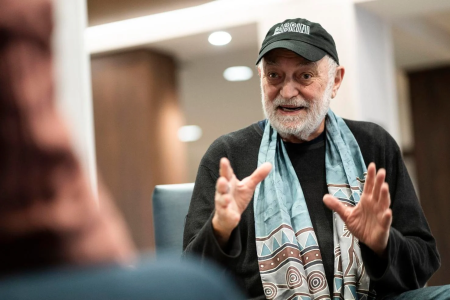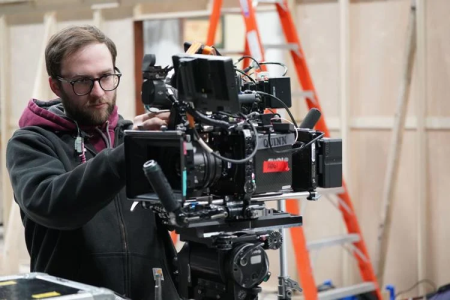
Lights, camera, Buffalo: Hollywood is back in town, and likely to grow
Multiple producers and directors are looking to film in Western New York this year. New York’s latest tax incentive for filmmakers makes this state, and particularly upstate, one of the most financially attractive places to shoot.
On a teeth-chattering Friday night in the Old First Ward, William Fichtner stood on the porch of an abandoned single-story home. He wore a thick and tattered utility jacket and crossed his arms, ostensibly straining to retain a touch of warmth on this 27-degree night. His silvery hair was disheveled; his face, bloodied. Snowflakes clung to his wispy beard as he locked eyes with his director.
“I’ll tell you, man, we’re blessed,” the filmmaker Michael Mailer said to Fichtner, who grew up in Buffalo but for decades has been based in Los Angeles. “I couldn’t have done this without you.”
Mailer and his crew, who were gathered around the porch, had just shot the final scene for the feature film “Cutman,” which stars Fichtner as a former professional boxer. Minutes earlier, Fichtner had been in character, tiptoeing around the dilapidated house and carrying a lead pipe (foam, in actuality) that he used to wallop the burly men in his way.

Actor William Fichtner, who grew up in Buffalo, prepares for a scene during filming for the movie “Cutman” on a soundstage at
Buffalo FilmWorks on March 20. Hollywood is happening in Buffalo more than most of us realize.
Derek Gee, Buffalo News
But now, Fichtner was back to being himself – a guy from Buffalo, clutching a Labatt Blue on a frigid night, ready to celebrate.
“It’s a collaboration I’ve never had before, and it’s honestly probably one I’ll never have again unless you’re involved,” Mailer said.
“Well, we’ll just have to do it again,” Fichtner responded.
The crew started clapping and cheering as Mailer and Fichtner grasped hands, shook and hugged.
Fichtner added, “As long as it’s shot in Buffalo!”
The crew cheered again. They knew there would be more of this to come.
Multiple producers and directors are looking to shoot in Western New York this year. The attraction is artistic and logistical – the region offers diverse settings and is easy to get around – and it’s fiscal, too. New York’s latest tax incentive for filmmakers makes this state, and particularly upstate, one of the most financially attractive places to shoot.

Director Michael Mailer makes sure the set is in order during filming for the movie “Cutman” on a soundstage at Buffalo FilmWorks.
Derek Gee photos, Buffalo News
‘A lot of interest’
Western New York is a known spot for filmmakers, especially when they’re looking for period architecture, seasonal weather, or the relatively easy ability to shut down a block, bridge or highway. Dozens of movies have been shot here over the decades, from 1984’s “The Natural,” which starred Robert Redford, to “A Quiet Place: Part II,” which John Krasinski filmed in 2019.The Western New York region has diverse and well-preserved architecture, along with waterways, open countrysides, multiple stadiums and, of course, Niagara Falls.
Many of those settings are artistically malleable, too. Buffalo’s City Hall, for example, has been used as a futuristic sci-fi version of the White House (2019’s “Crossbreed”) and as the Italian Senate from a century ago in the just-released “Cabrini.”
After a slowdown in filming caused by the pandemic and followed by both a writers’ and actors’ strike, directors are finally calling “Action!” more frequently in Buffalo and on sets across the country. Locally, the year has been steady already and may soon turn busy. At least four films have been partly or fully shot in Western New York in the first three months of 2024, and more are in the pipeline.
Mailer may be back as soon as this spring to produce “The Panic,” which is set in early-1900s New York City. Fichtner is hoping to return this summer, this time to direct a movie he wrote. The prolific director Fred Olen Ray, who has shot 13 films already in Buffalo, may do a 14th this year. The producers of an episodic television show are eyeing Buffalo as a place to shoot the pilot, and if it is picked up, possibly the series.
“We’re getting a lot of interest and a lot of calls,” said Tim Clark, commissioner of the Buffalo Niagara Film Commission. “(Filmmakers) understand the attraction of Buffalo.”
Producers and studios are also lured by a state incentive that provides a tax credit of up to 40% on many expenses for films shot in upstate New York. That’s a hefty incentive, and a more lucrative one than in years past. Before the pandemic, New York offered a 25% tax incentive (which then-Gov. Andrew Cuomo had lowered from 30%) with an extra 10% for shooting upstate. Last year, Gov. Kathy Hochul increased the incentive back to 30%, with the additional 10% for upstate, and the state added a few sweeteners to the deal: The old incentives covered only the costs associated with behind-the-scenes crew, or what filmmakers call “below the line” expenses. The pricier paychecks given to producers, writers, directors, actors and stunt professionals – which in filmmaking parlance are called “above the line” – weren’t covered. Goods and services, such as hotels, weren’t covered either.
Now, many of those bigger expenses can be included, and the annual statewide spending cap for the film tax incentive is $700 million, up from $420 million. That puts New York on level with Georgia, which, because of lucrative tax benefits, is home to a large film industry.

Jonathan Sanger, producer of "Cabrini," has made two feature films here. The first one, “Marshall,” was shot in 2016 and brought a
red-carpet cast to Buffalo, including Kate Hudson and the late Chadwick Boseman.
Libby March/Buffalo News
“New York State does have a great benefit,” said Oscar-winning filmmaker Jonathan Sanger, who produced the recently released “Cabrini” in Buffalo as well as 2017’s “Marshall.” “Upstate, the benefit is the best in the state, and probably the best in the country. People used to think that Georgia had the best benefit, but I think New York State now has a benefit that’s equal to Georgia, and you’ve got a more diverse amount of locations here.”
Though they do lure a glitzy industry to what would seem to be unlikely locales, the benefits of film tax credits are frequently questioned. Much like subsidies for the construction of sports stadiums, which the Buffalo Bills received in the form of $850 million from New York State and Erie County, challenging the fiscal benefits of providing incentives to filmmakers is a favorite target of some economists.
J.C. Bradbury, a professor of economics at Kennesaw State University in Georgia, told the New York Times last year, “I like to say that politicians love two things, jocks and movie stars. Any sports team that wants a subsidy, they’ll get it. Movies seem to get it as well.”
An analysis published last year by the New York State Department of Taxation and Finance showed that the film tax credits produced an estimated direct tax revenue of 15 cents on the dollar between 2018 and 2022. The return on investment improves slightly to 31 cents on the dollar when adding job creation.
That report incorporates results from across the state, including New York City, where major television and movie studios have long operated. In Western New York, the film industry has only truly blossomed in the last decade or so. Fifteen years ago, the region had only a handful of technical and creative professionals working on movie crews. Now, it has multiple unions and hundreds of workers, including some who are hired by Hollywood filmmakers to work on location in other cities or countries.
Most of the jobs you see listed in scrolling movie credits – from prop masters to lighting and sound professionals to craft services, which provide meals – can be found in Western New York. The local ranks of the International Alliance of Theatrical and Stage Employees has grown to more than 200, and the Screen Actors Guild is gaining members here too. The region has unionized cinematographers and local members of the Directors Guild of America, which appeals to filmmakers who, for financial reasons, want to hire locally. The Teamsters, which provides unionized drivers for film sets, has local members who work on movies.
“It’s really putting a lot of people to work,” Clark said, “at least in Western New York.”

First assistant camera operator Mike Thompson sets up the rig for the next shot during filming for "Cutman" at Buffalo FilmWorks.
Derek Gee/Buffalo News
More people may soon be needed. The City of Buffalo now has eight soundstages: Four at Buffalo FilmWorks on Babcock Street, one at Buffalo Toronto Public Media’s downtown headquarters, and three at the newly built Great Point Media on Niagara Street. In the coming weeks, a post-production studio – where editing, sound and other finishing processes take place – will open locally, too.
Those facilities, combined with the tax incentives, make it likely that Western New York will need additional film crew in the coming years. The Buffalo Niagara Film Commission is working with city and country workforce-development officials to arrange for training.
“We’re trying to get people interested and make them realize there’s a future here,” Clark said. “This isn’t a dream where you get a job in this business and move to New York and Los Angeles. You can actually make a perfect living in Western New York – and get New York City wages in upstate New York.”
Cultivating Buffalo boosters
Hollywood is happening in Buffalo more than most of us realize. On a single Thursday evening in mid-March, the Buffalo-born television writer Tom Fontana was visiting his hometown to shoot a short film, “The Wrong Road,” with a crew largely staffed by students from the Television and Film Arts program at his alma mater, SUNY Buffalo State University.At the same time, professional crew members around the area were getting calls about their availability the following week, when filmmakers who shot a movie mostly in Croatia were coming to town to film two days of footage here.
While all that was happening, Clark was working late at his desk on a budget breakdown for a major studio that had reached out about possibly filming in Buffalo. “Each one of these is like a moving target,” he said. “You get the calls, you answer the questions. They come up and scout. … Sometimes it happens, sometimes it doesn’t.”
Meanwhile, in the final couple of days of shooting “Cutman,” Mailer was directing Fichtner and his fellow actors in a scene shot inside Milo’s Diner, a small eatery down the street from KeyBank Center. Because of the tight space, the cast and crew used their dressing rooms at the Buffalo FilmWorks soundstage complex, which was a short drive away.

Crew members push an old pickup truck into position for a shot during filming for “Cutman.” Facilities like Buffalo FilmWorks,
combined with tax incentives, make it likely that Western New York will need additional film crew in the coming years.
Derek Gee, Buffalo News
The parking lot at Buffalo FilmWorks was lined with cars waiting to drive into one of the massive soundstages, which was temporarily being used as a distribution center for Girl Scout cookies. Walking into the studio that evening was a 10-year-old girl named Caroline Concannon, who appeared to be a Girl Scout showing up with her mom and dad to pick up cookies. But she was actually Fichtner’s co-star in “Cutman,” and showing up to work.
This was Caroline’s last night of filming; a couple of days later, she would return home to Long Island and resume her regular life as a fourth grader. Inside FilmWorks that night, she was talking about her three weeks in Buffalo. “We went to Niagara Falls a few times,” she said. “We go to cool parks.” She paused for a moment to try to remember the name of the lunch spot where she got a really good Caesar salad. She wasn’t quite placing it, but said, “There are a lot of good restaurants.”
Like her co-star Fichtner – or “Bill” as she calls him – Caroline was becoming a Buffalo ambassador.
